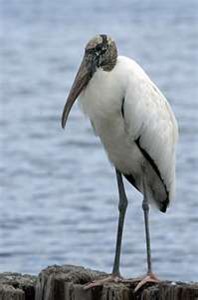(Mr. Jamsion writes from his Liberty County residence, but the birds mentioned in this article are also found in our area.)
The sixty five year old (plus) couple always looked forward to the evening sitting quietly in their small party cabin in the back yard watching the deer and game come to the feeder. Both of them are always on the watch for the unusual when the wife suddenly announced the arrival of the stork!
“Honey, are you alright? You spilled your tea. Did you doze off?
“Uuh….uhhh…I guess I felt a little faint all of a sudden. But didn’t you mention something about a st…sto….”?
“The stork…..oh yes…I saw five land in the big cypress tree down by the lake last week.”
The late summer or early fall is the time for flocks of storks, a gigantic bird, to show up in cypress swamp forest. Late summer is also the time (especially this year) when the water of swamps and lakes are at a long time low. Their principal diet of fish or other aquatic animals or insects are easily harvested by these great wading birds.
A common mistake most of us make is referring to storks and ALL wading birds as cranes. There obviously is some genealogical connection in the crane family because the wood stork or wood ibis, as some call, closely resemble the whooping crane, a highly endangered bird that winters in coastal Texas. The stork is slightly smaller than the ‘whoopers’ being over waist high to a man and with a wing span wide as a man is tall.
There is another similar cousin that also frequents fields and farms in this part of the world and that is the sand hill crane. Also a bit smaller than the stork but has the migrating flight characteristic of both the whooping crane and the wood stork which is almost totally soaring on heat thermals of air while displaying a circular graceful motion.
Cranes, ibis, anhinga (some call water turkeys) and a few others fly with their necks extended. On the other hand, the runner up of the stork might be the great blue heron. But as all herons and their relatives, they fly with their necks retracted. That is the easy way to classify these birds even if it is not always accurate.
Where are the great white herons? Well, they aren’t here unless some accidental happenings occur. They are principally found in the U.S. around the lower or tropical parts of Florida. What we confuse with the great white heron is a virtual look-alike of the great white egret. Great egrets are equal in size to the great blue heron with almost exact characteristics except color.
Of all the wading birds there are only a very few that are acceptable table fare. Each of those each is federally and state protected with seasons and limits. The prize would range from the very small rail family, Wilsons snipe to the giant sand hill crane. The sand hill crane is about a six pound bird with a heavy breast that is quite similar to a wild goose. Others would include curlews and all species of plover which are totally prohibited game at this time.
All in all, the nature show in the back yard is quite remarkable most any day. From the bird bath with a leaky faucet, to the spinning racket of the feeder discharging corn, milo, sunflower seeds and millet will always make an evening a remarkable memory.
Not long ago, we really got a shock to see a wild turkey pecking around the feeder. If a squirrel got a bit close or even a deer, the turkey hen would stand tall, flap her wings and announce she was there first! These wild turkeys though few, are due to the generosity of Pat Henscey of Henscey Electric Company. His thoughtful contribution in attempting to reestablish wild turkeys in Liberty County is only exceeded by his very tight control of poaching of any kind that might harm these delicate birds. Of course, turkey season is closed here also and local game wardens are well aware of where and when these birds are seen.
The evening enjoyment should often include an interested friend to join you. But please be careful when you mention the visit from the stork.
-Bob Jamison jbobalong@yahoo.com

